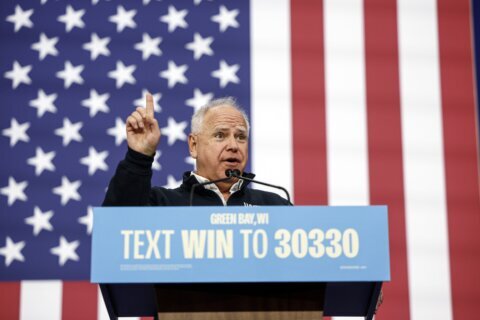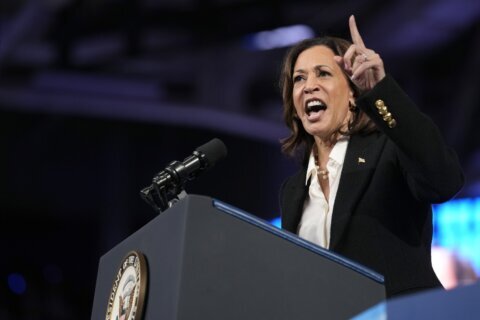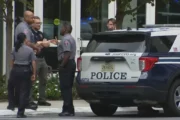WASHINGTON (AP) — As Election Day draws nearer, Democrat Kamala Harris is trying to maintain a diverse coalition of voters who were driven four years ago by their fierce opposition to Republican Donald Trump and anxiety over a deadly pandemic.
The former president, meanwhile, is looking to deepen gains among groups, such as men without college degrees, with whom he’s already shown strength, and erode Harris’ support among Hispanic Americans and other key demographics.
AP VoteCast, a sweeping survey of the electorate, tells the story of how Democrat Joe Biden won and Trump lost in 2020, and what those results could mean for the 2024 election. We’ll know whether the candidates were able to expand their coalitions — or build new ones — when results from the 2024 VoteCast survey are released on Election Day.
Biden’s victory four years ago was decisive but not overwhelming, leaving Harris with a challenge — she either needs to match his broad base of support, or shape a new winning coalition of her own.
According to AP VoteCast, Biden won clear majorities of college graduates, women and younger voters. He won around two-thirds of urban voters and more than half of suburbanites. He got the backing of around three-quarters of non-white voters, including about 9 in 10 Black voters and 6 in 10 Hispanic voters. And in addition to securing these groups, many of which have historically favored Democrats, Biden also won moderate voters and cut into Trump’s support among white women and young white voters.
Unlike Biden, Harris has tapped into the energy around her campaign by holding large rallies. But she’s also acknowledged the diversity of her coalition with various Zoom meetings that have targeted demographic groups such as “Black Women for Harris,” “Black Men for Harris,” “Latinas for Harris,” “Cat Ladies for Kamala” and “Dads for Kamala,” among other groups.
She has pushed hard to reach women by having a sit-down with the TV legend Oprah Winfrey and the podcast “Call Her Daddy.” She’s made direct outreach with labor unions that are part of the turnout operation in swing states, while also, as a Howard University alum, tapping into her connection with historically Black colleges, universities, fraternities and sororities.
Trump, meanwhile, held onto his base of white voters without a college degree, rural voters and religious conservatives in 2020.
He remained competitive in 2020, despite losing the popular vote, because these are large blocs and he won many of them decisively. In 2020, VoteCast found that about three-quarters of U.S. voters were white and 55% of them backed Trump. The president secured the support of around 8 in 10 white evangelical Christian voters. He won 6 in 10 voters living in small towns and rural areas, and was backed by roughly 6 in 10 white voters without college degrees.
It wasn’t enough to win him the White House four years ago, but his coalition is large enough for him to remain competitive in what will be his third time on a presidential ballot. White voters without college degrees represented about 43% of all voters in 2020, a foundation for his support that he has nurtured this year through large outdoor rallies and social media posts.
Trump, too, has gone on podcasts that tend to be popular with younger men, as well as courting major tech investors such as Elon Musk, who appeared with him at a recent Butler, Pennsylvania, rally that commemorated a prior assassination attempt. The former president has also publicly tried to court Black and Hispanic voters in his speeches. And he has also leaned into his brand as a businessman this campaign by launching a cryptocurrency business and selling sneakers and wristwatches, among other products.
But the 2020 election also took place at a very different moment for the country. Voters’ top issue in 2020 — the COVID-19 pandemic — is barely registering for Americans now. Four years ago, about 4 in 10 voters said the pandemic was the most important issue confronting the country and around three-quarters of those voters supported Biden.
The shift in issues could be helpful for Trump — but it’s not a guarantee. Inflation, immigration and abortion appear to be commanding most attention. Even in 2020, about half of voters said Trump was better able to handle the economy, while about 4 in 10 said this about Biden. There are signs that views on the economy are increasingly shaped by people’s own political views, and Harris is trying to erode the Republicans’ past advantage on the economy by focusing on policies to help middle class households manage costs.
The 2020 election was also in part a referendum on Trump, who was then the incumbent president. And while about 6 in 10 voters described their vote as mainly for their candidate, a sizable number — around 4 in 10 — said they were mostly voting against a candidate.
Harris has tried to suggest that, as a younger candidate who has never been president, she represents change, whereas Trump is also campaigning as a change candidate because he would break with Biden’s policies.
Many voters have signaled that they want a change and were initially unhappy about a Biden-Trump rematch, a concern that was allayed somewhat when Biden departed the race after a disastrous June 27 debate against Trump. In December 2023, an AP-NORC Center for Public Affairs Research poll found that 58% of U.S. adults said they would be dissatisfied if Trump was the Republican nominee, and 56% would be unhappy if Biden was the Democratic nominee.
The desire for change can be seen in higher enthusiasm among Democrats for Harris over Biden in AP-NORC polling since her emergence as a candidate. In September, polling found that more voters thought the phrase “would change the country for the better” described Harris, compared to Trump.
___
AP VoteCast is a survey of the American electorate conducted by NORC at the University of Chicago for Fox News, NPR, PBS NewsHour, Univision News, USA Today Network, The Wall Street Journal and The Associated Press. The 2020 survey of 110,485 voters was conducted for eight days, concluding as polls closed. Interviews were conducted in English and Spanish. The survey combines a random sample of registered voters drawn from state voter files; self-identified registered voters using NORC’s probability based AmeriSpeak panel, which is designed to be representative of the U.S. population; and self-identified registered voters selected from nonprobability online panels. The margin of sampling error for voters is estimated to be plus or minus 0.4 percentage points. Find more details about AP VoteCast’s methodology at https://apnews.com/ap-votecast-faq.
Copyright © 2024 The Associated Press. All rights reserved. This material may not be published, broadcast, written or redistributed.







